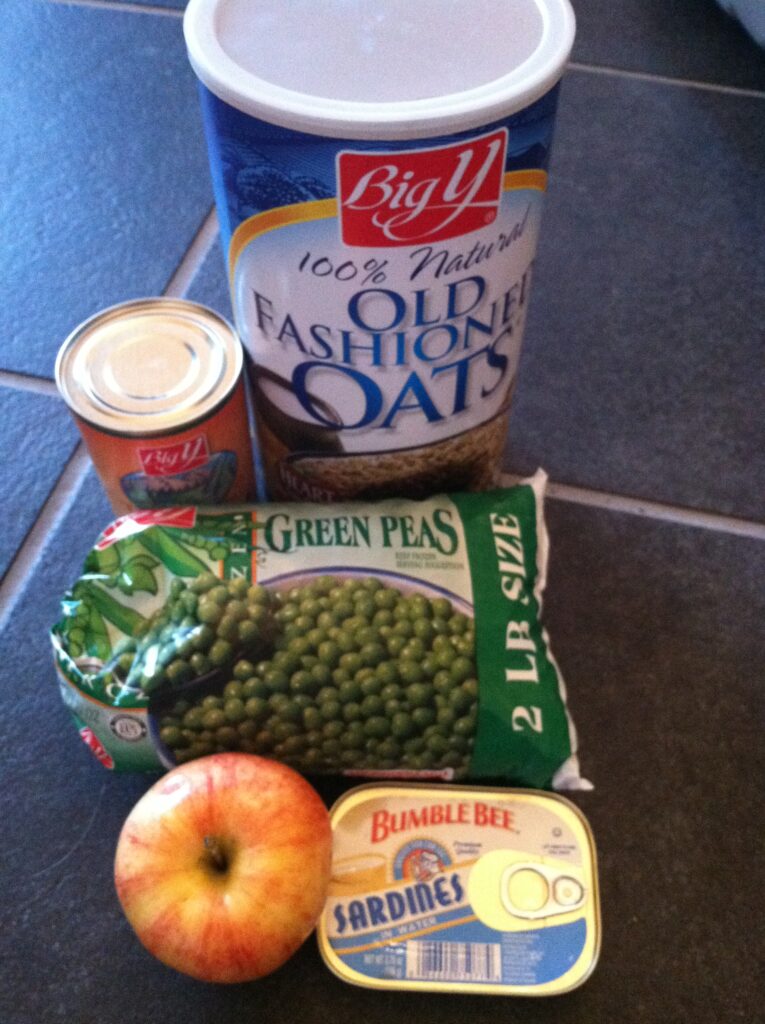Below is an article I wrote years ago, and it still applies. Cori was my golden retriever
mix who was fed real, human-grade, homemade foods beginning at age 7, and lived to
15 ½. Enjoy!
Grocery shopping is a regular ritual for all of us. As we navigate the aisles, sales and freebies, we can keep our dogs in mind and easily pick up ingredients for their diets too.
I spend lots of time in the produce department, and while I’m there I grab apples, broccoli, peppers, potatoes, sweet potatoes, cucumbers, celery, yellow squash, carrots, butternut squash, zucchini, watermelon and salad fixings.
In the oil aisle, I get extra virgin olive oil, unrefined coconut oil and apple cider vinegar.
Next is canned goods — perfect for stocking up on canned sardines and more. Oatmeal is in that aisle too, and I grab a container of organic quick cook oats. While I’m being tempted by frozen pizzas in the freezer aisle, I get bags of frozen spinach, zucchini and green beans. Add some eggs, yogurt and cottage cheese to the cart, and I’m almost done.

Finally, the meat department…. Here, I buy a whole chicken, a couple packages each of ground turkey and lean ground beef, and maybe some other options.
As I proceed through the checkout line, one thing is clear: a good deal of this stuff is for my dog, Cori.
Can you tell which ingredients are for her, and which are for me? It doesn’t really matter, because we share so much of it. I might make her that whole chicken, with some carrots, zucchini, potatoes and broccoli, and we will both enjoy it.
And that’s the way it should be. After all, I want to know what goes into my dog’s body, and I want to make sure it’s high quality enough to be considered “fit for human consumption.”
Making your own dog food is healthy and easy, once you learn the tricks of the trade. I transitioned Cori over to homemade food about six years ago, and never looked back. It’s the only way I know for sure what she’s eating. Aside from the health benefits, there’s the variety issue. We are always told to eat a variety of healthy foods — the same applies to our dogs. Starting slow and gradually adding new ingredients can help ensure your dog’s body adjusts.
Next time you go to the grocery store, think about including your dog in your shopping considerations. Even if you pick up one new item a week for your pup, you can help him or her lead a healthier life by including whole foods in his or her diet. Some dietary staples I feed Cori include:
· chicken, turkey and other poultry
· beef
· organ meats – liver, heart, gizzard, kidney etc.
· fish, fresh or canned
· brown rice
· vegetables including asparagus, carrots, broccoli, cauliflower, kale, chard, squash, spinach, occasional seaweed and so many more
· fruits including apples, watermelon, blueberries and many others
· plain unsweetened or vanilla yogurt
· eggs and well crushed shells
· olive oil
· coconut oil
· unsalted butter
· ground roasted flaxseeds
· oatmeal
These are just the beginning. Stock up on sales, canned goods and frozen items, and before you know it, you and your dog will be on the road to home cooking.
Other tips and shortcuts:
· Having eggs and oatmeal for breakfast? Make one or two extra eggs and a few spoonfuls of oatmeal for your dog.
· Turkey sandwich for lunch? Share with your dog (but avoid high salt cold cuts)
· Or did you have hamburgers for lunch? Give your dog a corner.
· Serving salad? See if your dog likes to sample sweet bell peppers, cucumbers, tomatoes – some dogs even like lettuce.
· Baked chicken, potatoes, and a vegetable for dinner? Share with your dog.
These are just a few examples. You will not always want to share, though, if your food is too salty, spicy or contains ingredients that are not good for dogs. Visit aspca.org for a list of dog-unfriendly foods.

